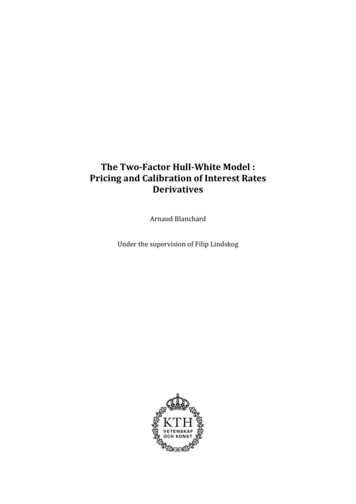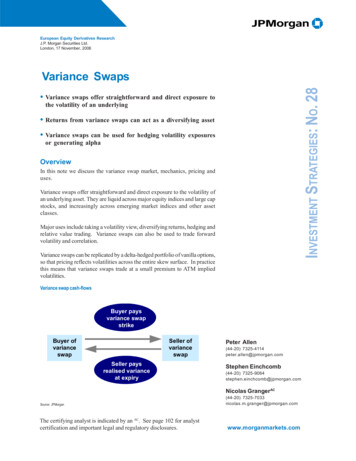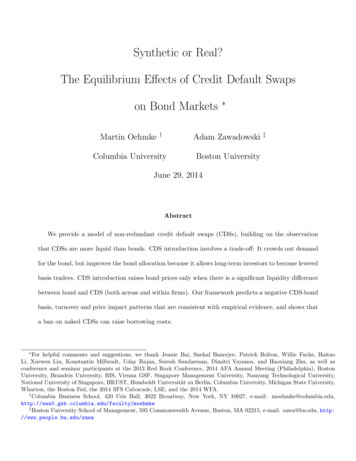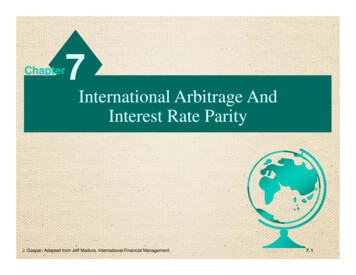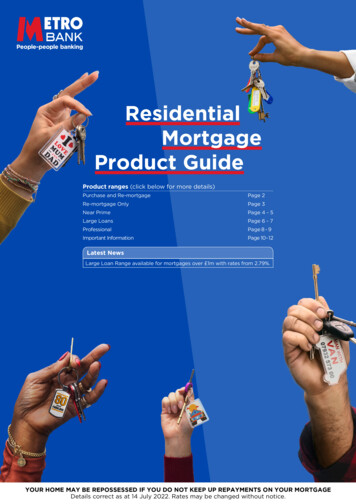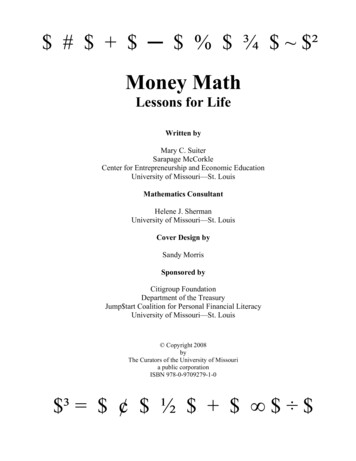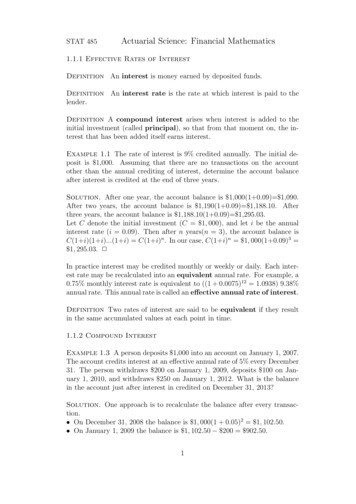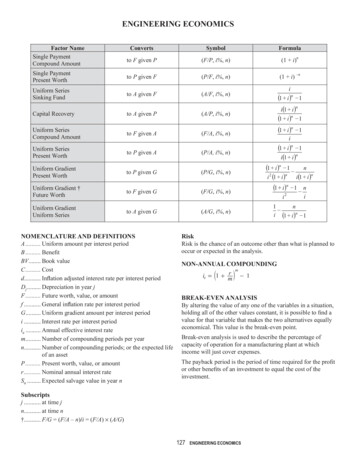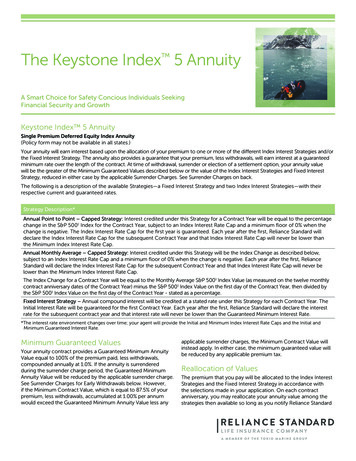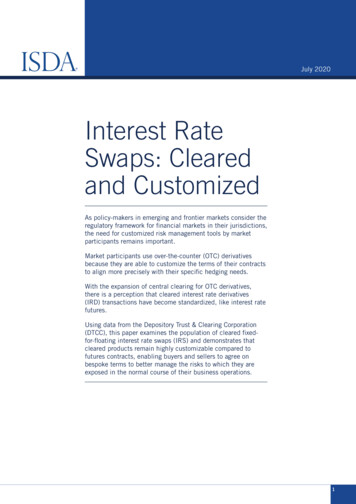
Transcription
July 2020Interest RateSwaps: Clearedand CustomizedAs policy-makers in emerging and frontier markets consider theregulatory framework for financial markets in their jurisdictions,the need for customized risk management tools by marketparticipants remains important.Market participants use over-the-counter (OTC) derivativesbecause they are able to customize the terms of their contractsto align more precisely with their specific hedging needs.With the expansion of central clearing for OTC derivatives,there is a perception that cleared interest rate derivatives(IRD) transactions have become standardized, like interest ratefutures.Using data from the Depository Trust & Clearing Corporation(DTCC), this paper examines the population of cleared fixedfor-floating interest rate swaps (IRS) and demonstrates thatcleared products remain highly customizable compared tofutures contracts, enabling buyers and sellers to agree onbespoke terms to better manage the risks to which they areexposed in the normal course of their business operations.1
Interest Rate Swaps: Cleared and CustomizedINTRODUCTIONAccording to the Bank for International Settlements (BIS), the share of IRD activityinvolving end users (including both financial institutions that are not ‘reporting dealers’and non-financial customers) totaled 76.0% in April 20191.These participants are based in numerous jurisdictions around world, reflecting ISDA’smembership, which includes derivatives users from 74 countries. They use OTC IRDbecause they are able to customize the terms of their contracts to align more preciselywith their specific hedging needs.OTC derivatives allow market participants to closely offset the risks they face andto ensure certainty in financial performance. For example, pension funds can usederivatives to hedge inflation and interest rate risk in long-dated pension liabilities,while governments and supranationals can use derivatives to reduce interest rate riskon new bond issuance.As policy-makers in emerging and frontier markets consider the regulatory frameworkfor financial markets in their jurisdictions, the need for customized risk managementtools by market participants remains important. However, with the expansion of centralclearing for OTC derivatives, there is a perception that cleared IRD transactions havebecome standardized, like interest rate futures.This paper examines the population of cleared fixed-for-floating IRS and demonstratesthat cleared products remain highly customizable, enabling buyers and sellers to agreeon bespoke terms to better manage the risks to which they are exposed in the normalcourse of their business operations. Using data from the DTCC2, ISDA identified 55 different reference rates for clearedfixed-for-floating IRS transactions in 2019. These swaps can further be differentiatedby the underlying reference rate tenor, reset frequency, and the day count, businessday and compounding convention. The transaction size of fixed-for-floating IRS is highly customizable. ISDA identifiedmore than 480 different transaction sizes for cleared fixed-for-floating IRS asmeasured by rounded notional amount3. Based on 2019 data, transaction sizesvaried from under 1,000 to 650 billion. The most common transaction sizes were100 million, 50 million and 25 million4.The BIS Triennial Central Bank Survey considers ‘other financial institutions’ (for example, pension funds, mutual funds, insurance companies, centralbanks, hedge funds, money market funds, building societies, leasing companies and smaller commercial and investment banks) as foreign exchangeand interest rate derivatives market end users. ‘Non-financial customers’ (for example, corporates and non-financial government entities) are regardedas non-financial end users. Entities in both of these categories use derivatives products for a variety of hedging and investment purposes, with the aimof managing risk and enhancing returns https://stats.bis.org/statx/srs/table/d12.12 This analysis is based on Depository Trust & Clearing Corporation interest rate derivatives traded and cleared notional and trade count data in 2019,and covers only transactions required to be disclosed under US regulations. Only fixed-for-floating interest rate swaps are included in this analysis3 All transactions that are reported with a ‘ ’ indicating a trade with capped notional were included in the block trade category; all transactions withcleared notional less than 1,000 were grouped in one category4 This part of the analysis is based on notional denominated in local currencies before being converted to US dollar1 2
Interest Rate Swaps: Cleared and Customized ISDA identified 497 different tenors for fixed-for-floating IRS in 2019, which rangedfrom less than three months to over 40 years5. In addition to various tenors, IRS can have a spot start, a forward start (internationalmonetary market (IMM) and non-IMM) and a backward start. There were 366different start dates for forward-starting IRS with non-IMM start dates.Tenor is calculated as the difference between the effective date and the maturity date and it is counted by a number of months for the purpose of this analysis5 3
Interest Rate Swaps: Cleared and CustomizedInterest Rate DerivativesAccording to the BIS OTC derivatives statistics, notional outstanding of global IRD totaled 449.0trillion with a gross market value of 8.4 trillion at the end of December 20196. The BIS IRD statisticsdata incorporates forward rate agreements (FRAs), options and IRS, which include overnight index swaps,fixed-for-floating and floating-for-floating swaps. IRS accounted for 76.0% of notional outstanding and89.4% of gross market value at the end of December 20197.Daily average turnover of global OTC IRD totaled 6.5 trillion in April 2019, of which 4.1 trillion wasIRS turnover 8,9. The share of IRD activity involving end users (both ‘other financial institutions’ and ‘nonfinancial customers’) was 76.0% in April 201910.Daily average turnover of IRD involving ‘other financial institutions’ totaled 4.5 trillion and accountedfor 69.6% of total IRD turnover, while daily average turnover of IRD involving non-financial customerstotaled 415.8 billion and accounted for 6.4% of IRD turnover. IRD trading activity between reportingdealers totaled 1.6 trillion and accounted for 23.9% of daily average IRD turnover in April 2010 (seeChart 1).Chart 1: Share of IRD Daily Average Turnover by Counterparty in April 2019Source: BIS Triennial Central Bank Survey 2019BIS OTC Derivatives Statistics https://stats.bis.org/statx/srs/table/d5.1?f pdfGross market value is the sum of the absolute values of all outstanding derivatives contracts with either positive or negative replacement valuesevaluated at market prices prevailing on the reporting date8 Turnover data provides a measure of market activity. It is defined as the gross value of all new deals entered into over a given period, and is measuredin terms of the notional amount of the contracts. OTC derivatives transactions that are centrally cleared via central counterparties are reported on a prenovation basis (ie, with the original execution counterpart as counterparty)9 The BIS Triennial Central Bank Survey 2019 https://stats.bis.org/statx/srs/table/d12.110 The BIS Triennial Central Bank Survey considers ‘other financial institutions’ as foreign exchange and interest rate derivatives market end users. ‘Nonfinancial customers’ are regarded as non-financial end users. Entities in both of these categories use derivatives products for a variety of hedging andinvestment purposes, with the aim of managing risk and enhancing returns6 7 4
Interest Rate Swaps: Cleared and CustomizedUnder the Bank for International Settlements (BIS) Triennial Central Bank Survey classification,‘other financial institutions’ include financial entities that are not classified as ‘reporting dealers’in the survey11. According to the BIS, these are typically regarded as foreign exchange and interestrate derivatives market end users. This category includes smaller commercial banks, investmentbanks and securities houses, mutual funds, pension funds, hedge funds, currency funds,money market funds, building societies, leasing companies, insurance companies, and financialsubsidiaries of corporate firms and central banks.These non-dealer financial institutions use derivatives for a variety of purposes. For example,pension plans hedge the interest rate and inflation risk inherent in long-dated pension liabilities.Insurance firms use derivatives to manage their assets and liabilities, hedge variable annuityguarantees and enhance investment income. Asset managers could use derivatives to hedgeunwanted interest rate or foreign exchange risk, protect portfolios against market volatility, quicklyrebalance asset allocations or take views on specific markets or sectors, and enhance returns12.‘Non-financial customers’ include mainly non-financial end users, such as corporations and nonfinancial government entities. This category may also include private individuals who directlytransact with reporting dealers for investment purposes.Non-financial market participants primarily use derivatives to mitigate risk, reduce balance-sheetvolatility, and increase certainty in cash flows, allowing firms to invest in new business initiativeswith greater confidence. For example, a corporate may decide to issue debt in foreign currencyto access a new investor base or tap into cheaper funding rates, then use a cross-currency swapto eliminate interest rate and currency mismatches. Governments may use derivatives to hedgeinterest rate risk on new bond issuance through interest rate swaps.Reporting dealers are financial institutions that participate as reporters in the triennial survey.These are mainly large commercial and investment banks and securities houses that: (i)participate in the interdealer market; and/or (ii) have an active business with large customers,such as large corporate firms, governments and non-reporting financial institutions.Reporting dealers actively buy and sell over-the-counter derivatives both for their own account and/or in meeting customer demand. Much of the dealer activity likely relates to market-making andhedging of customer transactions, which is critical for market liquidity and the facilitation of clienttrades.Bank for International Settlement Triennial Central Bank Survey: OTC interest rate derivatives turnover in April 2019, September 2019 https://www.bis.org/statistics/rpfx19 ir.pdf12 Dispelling Myths: End-User Activity in OTC Derivatives, August 2014 -final.pdf11 5
Interest Rate Swaps: Cleared and CustomizedFixed-for-floating Interest Rate SwapsThis analysis is based on traded and cleared notional and trade count for single-currency fixed-forfloating IRS13. This information was compiled based on the trading data reported to the DTCC andBloomberg swap data repositories (SDRs). This data includes only trades required to be disclosed underUS regulations.In 2019, fixed-for-floating IRS traded notional totaled 72.2 trillion and transaction count was 956.4thousand. The majority of that – 69.2 trillion (95.8%) of traded notional and 889.3 thousand oftransactions – was cleared. For comparison, fixed-for-floating IRS traded notional and transaction countin 2014 totaled 49.3 trillion and 639.7 thousand, respectively, and 79.3% of traded notional was cleared(see Table 1).Table 1: Fixed-for-floating IRS Traded and Cleared Notional and Trade CountTraded Notional(US trillions)Trade Count(thousands)Cleared Notional(US trillions)Cleared TradeCount (thousands)% of 201972.2956.469.2889.395.8%Source: DTCC and Bloomberg SDRsFixed-for-floating IRS average daily cleared notional increased from 150.2 billion in 2014 to 266.0billion in 2019, while average daily cleared trade count grew from 1,731 to 3,421 over the same period.Average cleared transaction size was 86.6 million in 2014 and 77.9 in 2019 (see Table 2).Table 2: Fixed-for-floating IRS Average Daily Cleared Notional, Average Daily Cleared TradeCount and Average Cleared Trade SizeAverage Daily ClearedNotional (US billions)Average DailyTrade CountAverage Trade Size(US 019266.03,42177.9Source: DTCC and Bloomberg SDRsA fixed-for-floating IRS is a swap in which one party makes periodic payments based on a fixed rate that is agreed upon at the execution of the swap,while the other party makes payments based on a floating rate that may be reset periodically13 6
Interest Rate Swaps: Cleared and CustomizedUnderlying Reference RateThe underlying reference rate is a specific interest rate that determines the floating interest rate portionof the IRS contract. Reference rates differ according to the particular type of borrowing cost that a rate isdesigned to measure and its methodology of compilation.Different reference rates allow market participants to hedge or mitigate interest rate exposures related toa particular borrowing or debt issuance. For example, a firm may enter into a fixed-for-floating IRS to fixinterest costs in connection with a floating rate loan or other borrowing.ISDA identified 55 different underlying reference rates for cleared fixed-for-floating IRS transactions in2019 (see Table 3). US dollar LIBOR, EURIBOR and sterling LIBOR were the most common underlyingreference rates. Cleared notional of IRS referencing US dollar LIBOR totaled 34.0 trillion and tradecount was 395.5 thousand. Cleared notional of the transactions referencing EURIBOR and sterlingLIBOR was 11.9 and 4.7 trillion and trade count totaled 156.4 and 66.4 thousand, respectively.Table 3: Fixed-for-floating IRS Cleared Notional and Trade Count by Underlying ReferenceRates in 2019Underlying Reference RateClearedNotional(US billions)ClearedTradeCountUnderlying Reference RateClearedNotional(US BA325.95,920USD-Federal -NFEA0.517PLN-WIBOR-WIBO307.68,277NZD POUND0.21CNY-CNREPOFIX 68CNY REPO CNRR007 BLMBERG ers41.4926USD-SIFMA Municipal Swap NY-ICA0.04USD-Federal -TAIBOR-Reuters26.3832Source: DTCC SDR7
Interest Rate Swaps: Cleared and CustomizedFixed-for-floating IRS with these underlying reference rates can be further differentiated by the underlyingreference rate tenor and reset frequency. As shown in Table 4, swaps cleared on CME that reference USDLIBOR-BBA have three different underlying index tenors (one, three and six months) and seven differentfrequencies of the rate reset14 (one week, two weeks, one month, two months, three months, six monthsand one year)15,16.Table 4: Underlying Reference Rates by Tenor and Reset FrequencyUnderlying Reference RateReference Rate TenorReset FrequencyAUD-BBR-BBSW3M, 6M1W, 2W, 1M, 2M, 3M, 6M, 1YCAD-BA-CDOR3M1W, 2W, 1M, 2M, 3M, 6M, 1YCHF-LIBOR-BBA6M1W, 2W, 1M, 2M, 3M, 6M, 1YCLP-TNAN/A1M, 3M, 6M, 1YCNY-CNREPOFIX CFXS-Reuters1W1WCZK-PRIBOR-PRBO6M1W, 2W, 1M, 2M, 3M, 6M, 1YDKK-CIBOR-DKNA136M1W, 2W, 1M, 2M, 3M, 6M, 1YDKK-CIBOR2-DKNA136M1W, 2W, 1M, 2M, 3M, 6M, 1YEUR-EURIBOR-Reuters1M, 3M, 6M1W, 2W, 1M, 2M, 3M, 6M, 1YEUR-EURIBOR-Telerate1M, 3M, 6M1W, 2W, 1M, 2M, 3M, 6M, 1YGBP-LIBOR-BBA1M, 3M, 6M1W, 2W, 1M, 2M, 3M, 6M, 1YHKD-HIBOR-HKAB3M1W, 2W, 1M, 2M, 3M, 6M, 1YHUF-BUBOR-Reuters6M1W, 2W, 1M, 2M, 3M, 6M, 1YJPY-LIBOR-BBA1M, 3M, 6M1W, 2W, 1M, 2M, 3M, 6M, OK-NIBOR-OIBOR6M1W, 2W, 1M, 2M, 3M, 6M, 1YNOK-NIBOR-NIBR6M1W, 2W, 1M, 2M, 3M, 6M, 1YNZD-BBR-FRA3M1W, 2W, 1M, 2M, 3M, 6M, 1YPLN-WIBOR-WIBO6M1W, 2W, 1M, 2M, 3M, 6M, 1YSEK-STIBOR-SIDE3M1W, 2W, 1M, 2M, 3M, 6M, 1YSGD-SOR-VWAP6M1W, 2W, 1M, 2M, 3M, 6M, 1YSGD-SOR-Reuters6M1W, 2W, 1M, 2M, 3M, 6M, 1YUSD-LIBOR-BBA1M, 3M, 6M1W, 2W, 1M, 2M, 3M, 6M, 1YZAR-JIBAR-SAFEX3M1W, 2W, 1M, 2M, 3M, 6M, 1YSource: CMEAdditionally, IRS transactions may have different day count conventions (which determine how interestaccrues over time), business day conventions (which specify how dates are adjusted when, for example, apayment day falls on a day that is not a business day), and compounding conventions (which may apply ifreset dates occur more frequently than payment dates).Transaction SizeIRS transaction size is the predetermined notional amount that is used to calculate the periodic paymentsdue between parties. This amount is not actually exchanged in the transactions, and does not reflect theamount of risk being transferred.Reset dates are days during the term of a rates transaction on which a floating reference rate is measured and -list.xlsx16 This table includes the data only for the reference rates that are provided on the CME website14 15 8
Interest Rate Swaps: Cleared and CustomizedThe flexibility to customize the notional amount of IRS transactions allows market participants toprecisely match the payment amounts between an IRS and a specific loan agreement, bond indenture orother debt instrument. Additionally, this flexibility allows market participants to better tailor their hedgepositions to enter into transactions with certain risk exposures17.The transaction size of fixed-for-floating IRS is highly customizable. ISDA identified more than 480different transaction sizes for cleared fixed-for-floating IRS as measured by rounded notional amount18.Based on 2019 data, the transaction sizes varied from under 1,000 to 650 billion.Table 5 shows that most cleared fixed-for-floating transactions fell in the transaction size range between10 million and 50 million and between 100 million and 500 million. There were 43 different transactionssizes in the range between 10 million and 50 million, 50 transaction sizes in the range between 50 millionand 100 million, and 40 transaction sizes in the range between 100 million and 500 million19.The most common transaction sizes are 100 million, 50 million and 25 million. In 2019, there were 38.1thousand of 100 million transactions, 34.1 thousand of 50 million transactions and 25.3 thousand of 25million transactions.Table 5: Fixed-for-floating IRS Cleared Trade Count by Transaction Size in 2019Transaction Size (TS) RangeCleared TradeCount Within EachRangeNumber ofDifferent TS withinEach RangeMost Frequent TSwithin Each RangeCleared TradeCount for MostFrequent TS 1 million28,460219500,0001,2931 million TS 10 million121,79292,000,00019,54410 million TS 50 million254,0114325,000,00025,28150 million TS 100 million134,9735050,000,00034,095100 million TS 500 million176,26140100,000,00038,055500 million TS 1 billion25,56210500,000,0007,5351 billion TS 5 billion38,53541,000,000,00014,5595 billion TS 10 billion11,02855,000,000,0004,31010 billion TS 50 billion17,5634010,000,000,0003,27450 billion TS 100 billion2,9745050,000,000,000482 100 billion1,43010100,000,000,000537Block trades76,760101170,000,00013,935Source: DTCC SDRAdditionally, some market participants use variable notional swaps (VNS), also known as amortizingswaps, to hedge non-standard risks. These instruments have legs with increasing or decreasing notionals.For example, parties may enter into VNS to offset balloon payment provisions of loans or lease agreementsor to reduce risk exposure to securities that have a sinking fund or early redemption provisions.The objective of hedging a fixed income position with IRS is to ensure that, if an underlying security loses its value, then this loss would be offset by acomparable gain in the hedge position. Instead of matching notional values of the positions, the best way to hedge is to match the dollar value of a onebasis point change (DV01) in the yield of the underlying security and that of the hedging transaction18 All transactions that are reported with a ‘ ’ indicating trades with capped notional were included in the block trade category; all transactions withcleared notional less than 1,000 were grouped in one category19 This part of the analysis is based on notional denominated in local currencies before being converted to US dollar17 9
Interest Rate Swaps: Cleared and CustomizedTenorTenor is the time between the effective date and the maturity date of an IRS contract, and can range froma few days to many years. Transactions with a longer tenor are considered more risky because there is moretime in which the value might change.Depending on risk tolerance and financial objectives, market participants may choose transactions withshorter or longer tenors. For example, a company that needs to manage its short and medium-terminterest rate risk might use IRS with tenors of five years or less. Additionally, the ability to customizetenors allows investors to better align the tenor of hedges with the maturity of debt instruments beinghedged.ISDA identified 497 different tenors for fixed-for-floating IRS in 2019, which ranged from less than threemonths to over 40 years. For the purpose of this analysis, tenor was measured by the number of monthsbetween the effective date and the maturity date of the trade.Based on cleared notional within each tenor range set out in Table 6 and Table 7, most transactions werebetween one and three years and five and seven years. Based on the trade count for the same tenor ranges,most transactions were between five and seven years and 10 and 15 years.The most common tenors for fixed-for-floating IRS in 2019 were 24 months, 60 months and 120months.Table 6: Fixed-for-floating IRS Cleared Notional by Tenor in 2019TenorCleared Notional(US trillions)Number of DifferentTenors within EachRangeMost FrequentTenor (months)Cleared Notionalfor Most FrequentTenor (US trillions)Tenor 3M0.90320.623M Tenor 6M6.61336.136M Tenor 1Y2.23661.611Y Tenor 3Y25.42242412.653Y Tenor 5Y5.9124363.355Y Tenor 7Y12.79246011.377Y Tenor 10Y3.5136841.5310Y Tenor 15Y8.31601207.9315Y Tenor 20Y0.65601800.4920Y Tenor 30Y1.031202400.5730Y Tenor 40Y1.76803601.74Tenor 40Y0.04574800.02Source: DTCC SDR10
Interest Rate Swaps: Cleared and CustomizedTable 7: Fixed-for-floating IRS Cleared Trade Count by Tenor in 2019TenorCleared Trade Count Number of Different(thousands)Tenors within EachRangeMost FrequentTenor (months)Trade Count forMost FrequentTenor (thousands)Tenor 3M3.2322.93M Tenor 6M26.33323.36M Tenor 1Y12.9668.21Y Tenor 3Y157.92424100.93Y Tenor 5Y69.0243639.65Y Tenor 7Y212.62460192.17Y Tenor 10Y66.8368426.010Y Tenor 15Y201.460120191.215Y Tenor 20Y17.76018013.820Y Tenor 30Y33.312024018.830Y Tenor 40Y85.98036084.5Tenor 40Y2.4574801.3Source: DTCC SDRStart DateThe start date of an IRS is the date on which parties begin calculating accrued fixed and floating interestrate payments. IRS can have a spot start, a forward start (IMM and non-IMM) or a backward start (whichincludes trades reported late or underlying swaps from exercised swaptions).A spot start date means that a transaction becomes effective typically within one or two business daysafter the execution date, although the effective date for some IRS can be the same as the execution date.For forward-starting IRS, the effective date is usually further ahead of the execution date. For IRS withan IMM start, the effective date falls on the third Wednesday in March, June, September and December.Other forward-starting IRS have non-IMM start dates. Backward-starting IRS have the effective datebefore the execution date.Forward-starting IRS allow market participants to lock in certain rates that are being offered today basedon the expectation that interest rates might change in the future. Investors can use different start dates toalign the effective date of the forward-starting IRS with the funding date of a loan being hedged.In 2019, 24.9 trillion of cleared IRS transactions had a spot start; 36.2 trillion had a forward start,including 8.5 trillion with an IMM start and 27.7 trillion with non-IMM start dates; and 8.1 trillionhad a backward start (see Table 8).Table 8: Fixed-for-floating IRS Cleared Notional and Trade Count by Start Date in 2019Cleared Notional(US trillions)Cleared Trade Count(thousands)Spot start24.86372.3IMM start date8.51139.7Non-IMM start date27.65223.6Backward start8.14153.7Source: DTCC SDR11
Interest Rate Swaps: Cleared and CustomizedISDA identified 366 different start dates (calculated in months) for forward-starting IRS with non-IMMstart dates (see Table 9 and Table 10).Table 9: Fixed-for-floating IRS Cleared Notional by Non-IMM Forward Start in 2019Non-IMMForward Start (FS)Cleared Notional(US trillions)Number of DifferentForward Start withinEach RangeMost FrequentForward Start(months)Cleared Notional forMost Frequent ForwardStart (US trillions)FS 3M8.54313.093M FS 6M3.95332.046M FS 1Y4.41661.261Y FS 3Y6.0724121.443Y FS 5Y2.1724360.545Y FS 7Y1.1924600.647Y FS 10Y0.5636840.1010Y FS 15Y0.40601200.1915Y FS 20Y0.17601800.0620Y FS 30Y0.16922400.0630Y FS 40Y0.02293600.01FS 40Y0.0054800.00Source: DTCC SDRTable 10: Fixed-for-floating IRS Cleared Trade Count by Non-IMM Forward Start in 2019Non-IMMForward Start (FS)Cleared TradeCount (thousands)Number of DifferentForward Start withinEach RangeMost FrequentForward Start(months)Trade Count for MostFrequent Forward Start(thousands)FS 3M71.93026.53M FS 6M28.73315.26M FS 1Y30.96611.11Y FS 3Y37.624129.03Y FS 5Y19.524363.65Y FS 7Y16.424609.77Y FS 10Y6.836840.910Y FS 15Y5.9601203.015Y FS 20Y2.8601800.920Y FS 30Y2.6922401.130Y FS 40Y0.4293600.2FS 40Y0.154800.1Source: DTCC SDR12
Interest Rate Swaps: Cleared and CustomizedCONCLUSIONThis paper examines the population of cleared fixed-for-floating IRS and demonstrates that clearedderivatives remain highly customizable as compared to futures contracts, enabling buyers and sellers toagree on bespoke terms to better manage the risks to which they are exposed to in the normal course oftheir business operations.The ability to customize cleared derivatives allows end users to better hedge interest rate, currency, foreignexchange and inflation risk; manage their assets and liabilities; protect investment portfolios againstmarket volatility; reduce balance-sheet volatility; and increase certainty in cash flows. All these activitieshave important economic and social benefits.13
Interest Rate Swaps: Cleared and CustomizedISDA has published other recent research papers: Key Trends in the Size and Composition of OTC Derivatives Markets in theSecond Half of 2019, June 2019.pdf IRD Block Trading Activity in the First Quarter of 2020, June -Activity-in-the-First-Quarter-of-2020.pdf SwapsInfo First Quarter of 2020 Review, April -Review-Full-Report.pdfFor questions on ISDA Research, please contact:Olga RomanHead of ResearchInternational Swaps and Derivatives Association, Inc. (ISDA)Office: 212-901-6017oroman@isda.orgABOUT ISDASince 1985, ISDA has worked to make the globalderivatives markets safer and more efficient.Today, ISDA has more than 900 memberinstitutions from 74 countries. These memberscomprise a broad range of derivatives marketparticipants, including corporations, investmentmanagers, government and supranational entities,insurance companies, energy and commoditiesfirms, and international and regional banks. Inaddition to market participants, members alsoinclude key components of the derivatives marketinfrastructure, such as exchanges, intermediaries,clearing houses and repositories, as well aslaw firms, accounting firms and other serviceproviders. Information about ISDA and itsactivities is available on the Association’s website:www.isda.org. Follow us on Twitter, LinkedIn,Facebook and YouTube.14
IRS accounted for 76.0% of notional outstanding and 89.4% of gross market value at the end of December 20197. Daily average turnover of global OTC IRD totaled 6.5 trillion in April 2019, of which 4.1 trillion was IRS turnover8,9. The share of IRD activity involving end users (both 'other financial institutions' and 'non-
